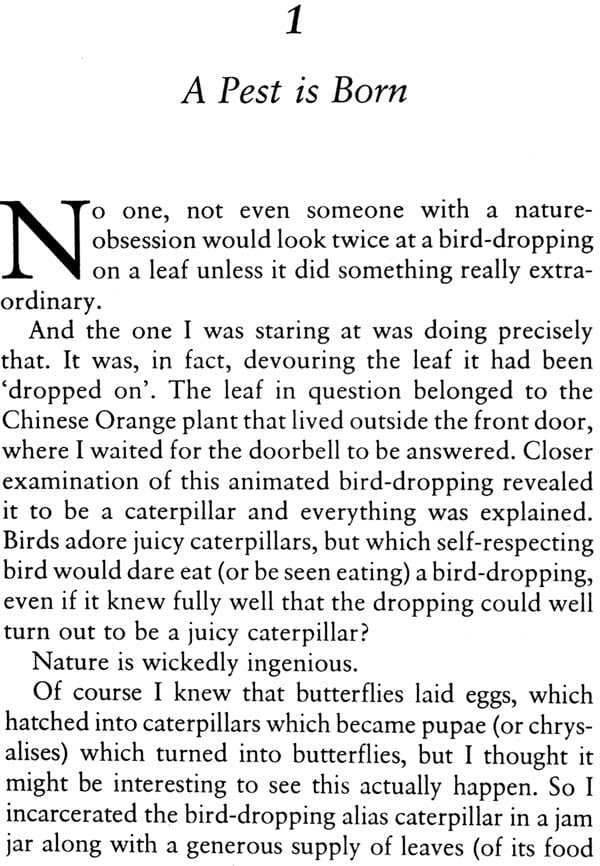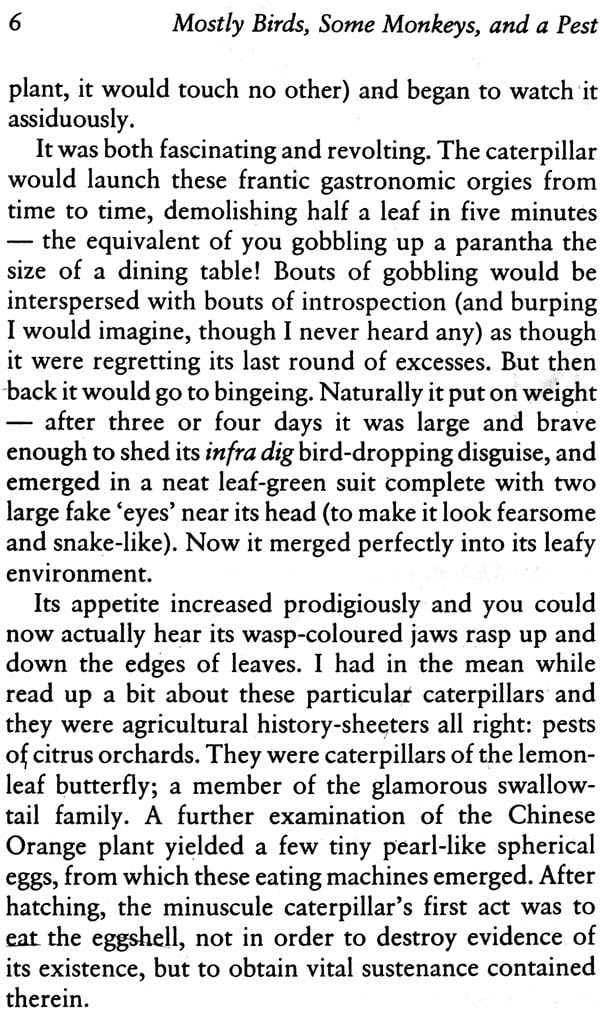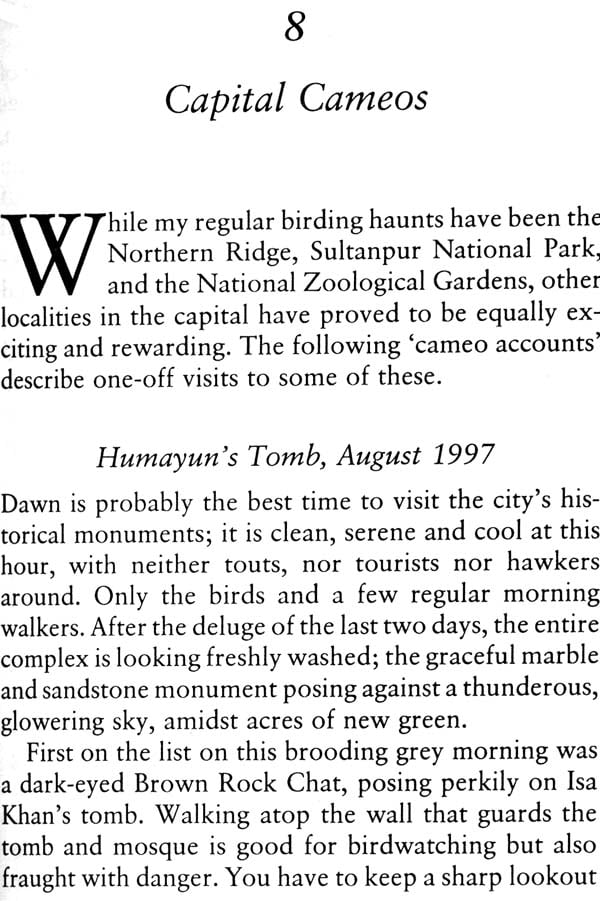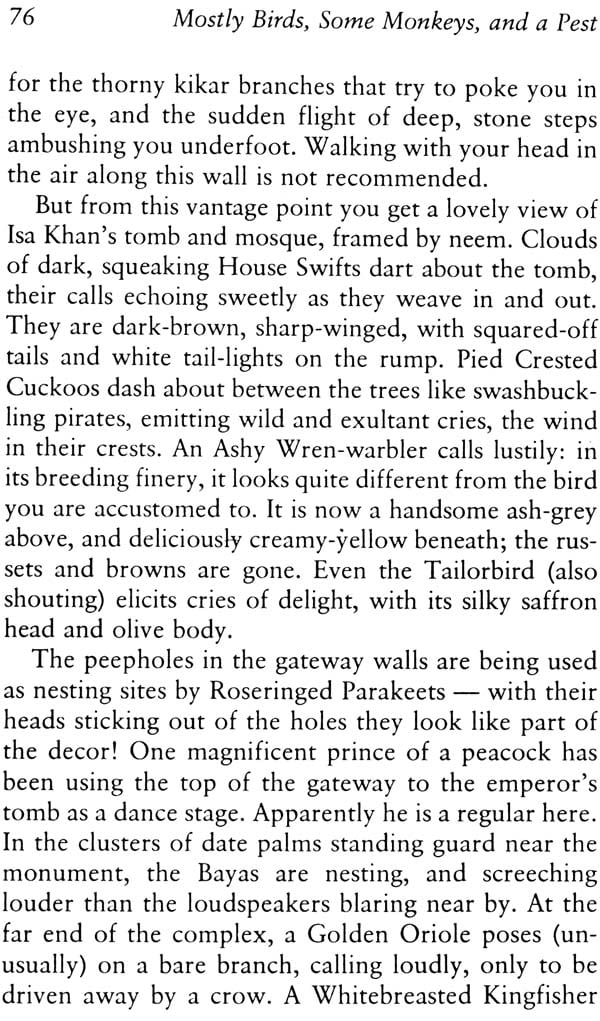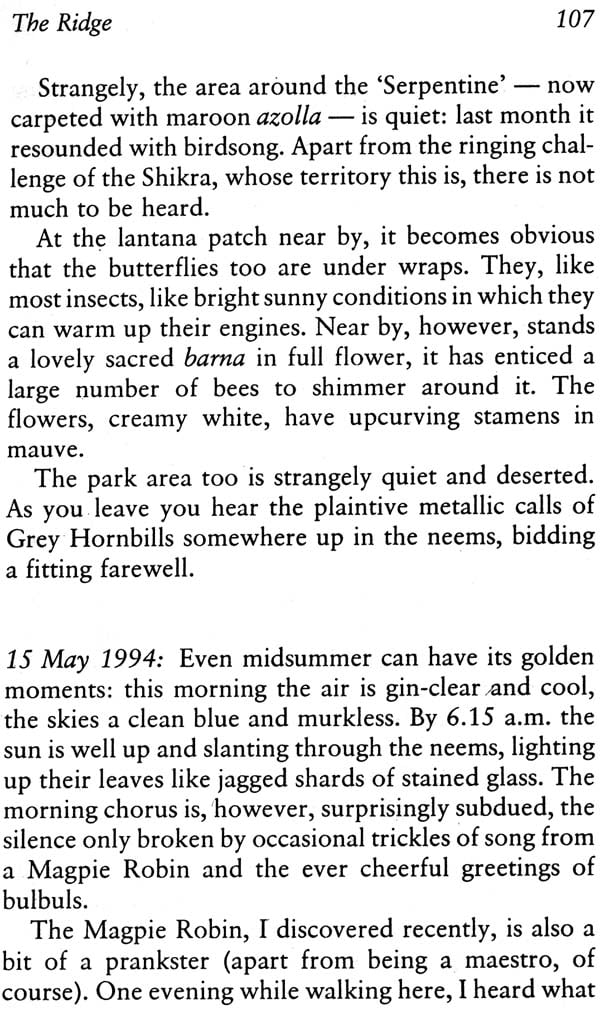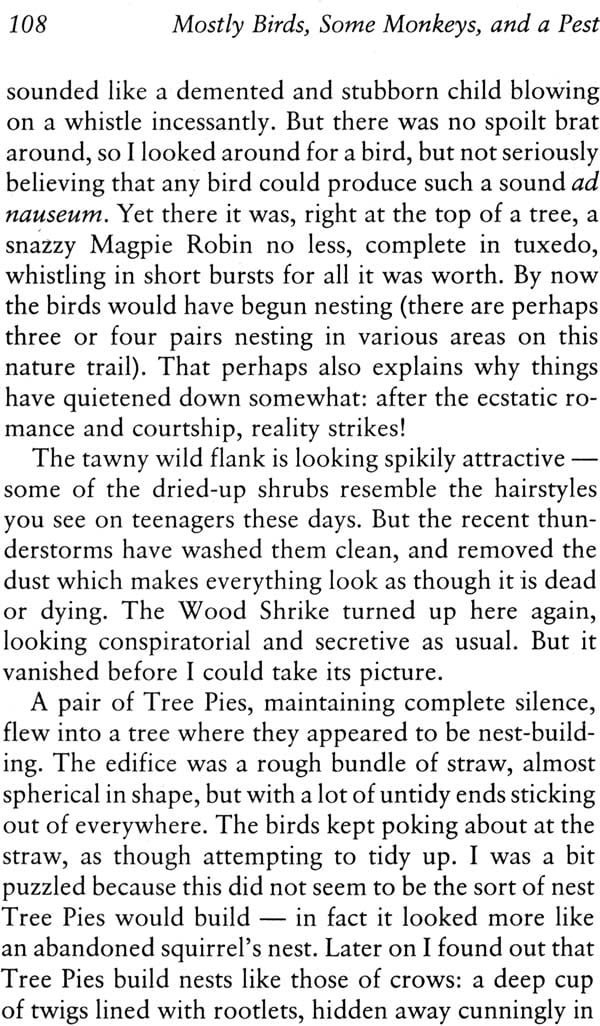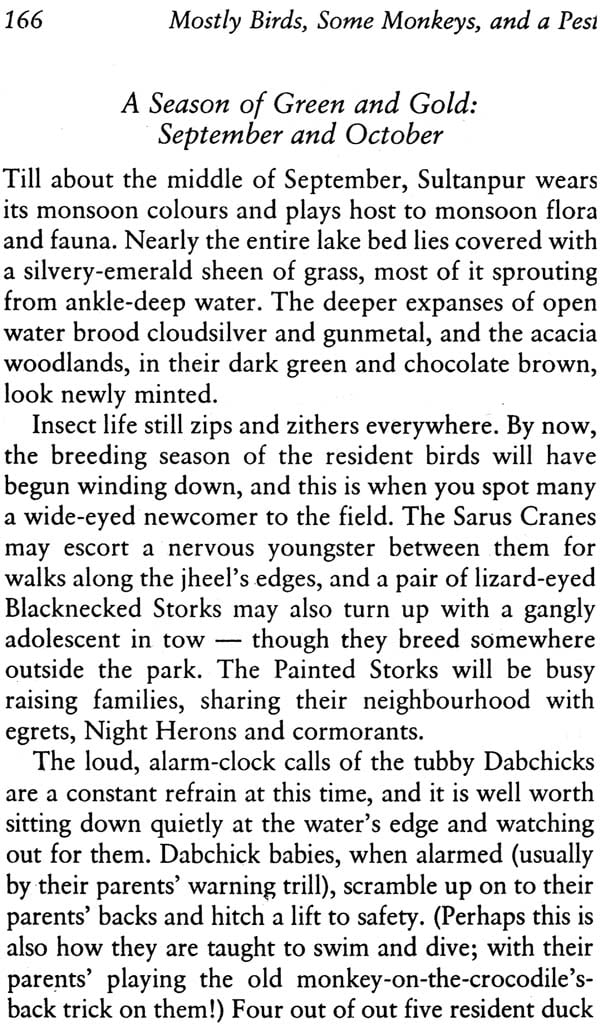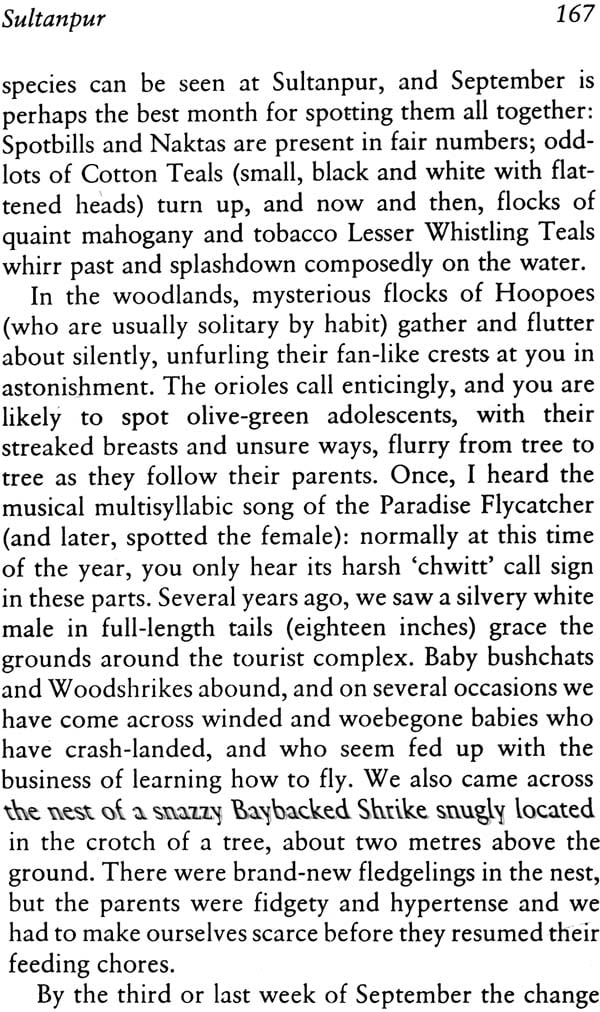
Mostly Birds, Some Monkeys, and a Pest (Nature in and Around Delhi)
Book Specification
| Item Code: | NAH527 |
| Author: | Ranjit Lal |
| Publisher: | Ravi Dayal Publisher |
| Language: | English |
| Edition: | 2000 |
| ISBN: | 8175300329 |
| Pages: | 188 |
| Cover: | Hardcover |
| Other Details | 7.5 inch x 5 inch |
| Weight | 260 gm |
Book Description
Delhi is officially the fourth most polluted city in the world, but it is also one of the greenest in India, with a rich bird life remaining close at hand and often at your doorstep. This entertaining and instructive volume contains Ranjit Lal's observations on nature around his home in Delhi, at the Old Delhi Ridge, along the Yamuna, in the Zoo and at some other sites such as Humayun's Tomb, JNU and Okhla. There are also descriptions of the bird life once visible in nearby Sultanpur which, together with those on the Ridge, cover each month of the year over a -span of time. Of the ten chapters in this volume, eight focus on birds, but it also has one about a caterpillar turning into a butterfly; and in another chapter there is the stirring saga of the monkeys ruling from the Nicholson cemetry near Kashmiri Gate. Mostly Birds … wittily brings an attractive aspect of Delhi alive and, at the same time, provides the lay reader a useful and wonderfully readable ornithological tour of the region.
Ranjit Lal was born in Calcutta in 1955. He was educated in Mumbai and now lives in Delhi. As a freelance writer, he has had over 1000 articles, feature and photo-feature published in newspaper and magazines in India and abroad. These are mostly on natural history, particularly birds; but his range includes automobiles too. Ranjit Lal is the author of Enjoying Birds, an illustrated book on bird-watching, and of two highly-acclaimed novels—The crow chronicles and The Life and Times of Altu-Faltu: A Fable.
So you live in a big, noisy polluted, cement-clad city and lead .a gruelling nine-to-six five-day existence? During weekends you simply pass out in front of the television set. Sometimes you dream of giving it all up; of buying a cottage in the mountains or a villa by the sea. Of 'communing with nature' (as the tired phrase goes), of simply 'standing and staring You can't even remember the last time you saw a butterfly hatch, or stars sprinkled across the night sky, or a skein of migratory birds flying overhead. Except perhaps in a television programme or a horrifyingly expensive coffee-table book. You envy the people who make those programmes and write those books; it must be wonderful to be able to tramp around to all those beautiful places for months on end. But no, you're trapped in the city, inhaling its pollution and cursing its murderous traffic. What a life!
I've often thought like that (and still do), but since I really couldn't do very much about it, decided to make the best of a bad job and do what 'nature watching’ I could, here in the city itself. I live in Delhi,
officially the fourth-most polluted city in the world and, ironically, one of the greenest in India!
Anyway, about fifteen years ago I even started keeping notes on all the 'natural' phenomena I observed around the house, the garden, and the neighbourhood, and when I managed to go on short but cherished trips out of town. As I was 'specially interested' in birds, they were naturally given most of my attention. Now, while leafing through over a thousand pages of notes, I find that I can't really grumble about having led a supposedly arid and synthetic existence. And that some of the most interesting (and hilarious) 'natural' events have occurred right outside my bedroom window.
Of course it is wonderful to leave the city and go off into the wilderness; to a national park or sanctuary, or a retreat in the hills, or a pristine, shimmering beach. My forays have been few and far between, and never for the length of time I would have liked (are they ever?). But always, I've come back with a head crammed full of images, incidents, colours and discoveries. And I'm amazed when people return from the most exotic places and shrug and remark, 'it was okay', or 'kuch khas nahin tha'.
I've found that something interesting if not extraordinary nearly always happens; whether you are 'nature watching' in your pocket-handkerchief garden, or in a magnificent Tiger Reserve. All you really have to do is be a quiet, patient witness. One dilemma that you are invariably faced with while out in the wilds, is whether to 'conquer' the entire area by tramping or driving through it, or simply sitting put at a strategically chosen spot and waiting for nature to come to you, so to speak. Walking (or driving) through gives you the mental satisfaction of having 'seen' the place fully, whereas sitting put in one place improves your chances of seeing something remarkable happen: a butterfly hatching, a hawk hunting; elephants enjoying a bath, or even a tigress playing with her cubs. Actually, it's rather like choosing between 'doing' all the sights in a city in a single day, or just going to one and seeing it properly.
This book is devoted to observations I have made in and around my home in Delhi, at the Old Delhi Ridge, the Yamuna, the National Zoological Park, and other sites in Delhi; and the Sultanpur National Park in next- door Haryana. Some of these areas have changed terribly in the last ten years or so. For example, the fields near Rajghat, once rich in bird life, have been taken over by the Rajghat Power Station, and much of the Yamuna River Front Park has been demolished for an elaborate clover-leaf f1yover. Most of the grand old trees in the historic Nicholson cemetery in Old Delhi were senselessly hacked down in the spring of 1991, leaving a once verdant, wooded area, barren, bald and baking.
There is a sense of well-being and satisfaction "that comes from observing, and being with, nature that you cannot get from artificial means or stimuli, no matter how 'virtually real'. By being a witness 'in the field' (or even in your garden or city park) you become a participant almost, in the grand scheme of things; in natural history in the making. At any rate I have always found that my 'Nicholson macaques' have provided me with better entertainment than any television comedy serial: in any case, the monkeys insist that you watch them instead of television by biting through the cable or twisting the aerial out of shape!
Apart from the entertainment provided, there was a curiosity that was aroused. What was the function of the lurid filamentous antennae that caterpillars flicked out at you when you breathed hard on them? Was Rambo plotting a coup d' etat against Big Boss to take over the Nicholson macaques, or would NATO intervene? Did the delta-winged hawk-moth I hatched in my bedroom use chemical weapons against me when I tried to take its photograph? Why did angry mynas sound like angry fishwives when a cat was around? What kind of target-guidance system did a bee-eater use to home in on a dizzy bee, zipping about fifty feet up in the wide blue sky? Were the pigeons that nested in the service station next door hooked on petrol fumes, or simply mentally defective because of lead- poisoning? Were the golden munias I discovered on the Old Delhi Ridge a new species?
To some of these questions I have found answers. Others remain unsolved mysteries. One thing I am sure of. Regardless of where you live, the wonders (and forces) of nature remain close at hand. All you have to do is to keep your eyes open, your ears pricked and your wits about you. And maybe you will discover a whole new world on your doorstep.
| 1 | Introduction | 1 |
| 2 | A Pest is Born | 5 |
| 3 | The Reluctant Bottlebrush | 12 |
| 4 | Quiet Neighours | 16 |
| 5 | Birdhits | 26 |
| 6 | The Nicholson Macaques | 30 |
| 7 | The Yamuna: From Rajghat to Tibdabs' | 51 |
| 8 | Zoo Interludes - Extracts from Field Notes | 62 |
| 9 | Capital Cameos | 75 |
| 10 | The Ridge | 89 |
| 11 | Sultanpur | 131 |
